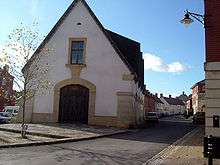Poundbury
| Poundbury | |
 Middlemarsh Street |
|
 Poundbury |
|
| Population | 2,500 |
|---|---|
| OS grid reference | SY671549 |
| District | West Dorset |
| Shire county | Dorset |
| Region | South West |
| Country | England |
| Sovereign state | United Kingdom |
| Post town | DORCHESTER |
| Postcode district | DT1 |
| Dialling code | 01305 |
| Police | Dorset |
| Fire | Dorset and Wiltshire |
| Ambulance | South Western |
| EU Parliament | South West England |
| UK Parliament | West Dorset |
Coordinates: 50°42′48″N 2°27′58″W / 50.7133°N 2.466°W
Poundbury is an experimental new town or urban extension on the outskirts of Dorchester in the county of Dorset, England.
The development is built on land owned by the Duchy of Cornwall. It is built according to the principles of Prince Charles, who is known for holding strong views challenging the post-war trends in town planning that were suburban in character.
Plan
The development is built to a traditional high-density urban pattern, rather than a suburban one, focused on creating an integrated community of shops, businesses, and private and social housing. There is no zoning. The planners say they are designing the development around people rather than the car, and they aim to provide a high-quality environment, from the architecture to the selection of materials, to the signposts, and the landscaping. To avoid constant construction, utilities are buried in common utility ducts under the town. Common areas are maintained by a management company to which all residents belong.[1]
To some degree, the project shows similarities with the contemporary New Urbanism movement, except that the design influences are European. The design of the houses are in traditional and new classical styles, with period features such as bricked-up windows, a feature found on many old British buildings, due to the window tax.[2]
Poundbury's aesthetics have been criticized by several commentators.[3][4] Architecture writer Jonathan Meades labelled the town a "cottagey slum" and a "Thomas Hardy theme-park for slow learners".[5] ARCHITECT magazine's Witold Rybczynski, however, says that "Poundbury embodies social, economic, and planning innovations that can only be called radical."[3]

The overall plan was developed in the late 1980s by the Luxembourgian architect Leon Krier, and construction started in October 1993. Krier's plans have been criticised for mixing too many different continental styles and the use of non-local building materials, which are not consistent with the traditions of Dorchester. It is expected that the four plan phases will be developed over 25 years with a total of 2,500 dwellings and a population of approximately 6,000.
Greetings card entrepreneur Andrew Brownsword sponsored the £1 million development of the market hall at Poundbury, designed by John Simpson and based on early designs, particularly the one in Tetbury.[6]
Following New Urbanist principles, Poundbury was intended to reduce car dependency and encourage walking, cycling, and public transport. A survey conducted at the end of the first phase, however, showed that car use was higher in Poundbury than in the surrounding (rural) district of West Dorset.[7] Nonetheless, the community is receiving positive recognition from New Urbanist publications such as Better Cities and Towns.[8]
Economy
One notable local employer since 2000 is the breakfast food manufacturer and exporter Dorset Cereals, which employs more than 100 people at its purpose-built barn factory.[9]
Gallery
-

The Whistling Witch (affectionately) 2008
-

The new Dorset Fire and Rescue Service HQ/Fire station nears completion September 2008
-

Brownsword Hall in Poundbury, designed by architect John Simpson and based on earlier traditional designs, particularly one in Tetbury
-

Dorset Cereals Factory
See also
- Fairford Leys - A very similar project located on the edge of Aylesbury
- Poundbury Hill – an Iron Age hill fort near Poundbury
References
- HRH Charles, Prince of Wales: A Vision of Britain: A Personal View of Architecture (Doubleday, 1989) ISBN 0-385-26903-X
- Leon Krier: Architecture: Choice or Fate (Andreas Papadakis Publishers, 1998) ISBN 1-901092-03-8
- Sandy Mitchell. "Prince Charles is not your typical radical." National Geographic. May 2006. Accessed online 9/14/06
Notes
- ↑ Pentreath, Ben, How the Poundbury project became a model for innovation, The Financial Times, November 1, 2013
- ↑ "Around Poundbury". BBC Dorset. July 2008. Retrieved 19 April 2013.
- 1 2 Rybczynski, Witold (3 December 2013). Behind the Façade of Prince Charles's Poundbury. Architect.
- ↑ Bayley, Stephen (7 December 2008). "I'll show you a real carbuncle, Charles". The Guardian.
To visit Poundbury is to be delivered to the furniture floor of a provincial department store in 1954, translated into architecture. It is fake, heartless, authoritarian and grimly cute.
- ↑ Seale, Jack (2 February 2013). "That Week On TV: The Joy of Essex, BBC4; The Story of Music, BBC2". Radio Times.
- ↑ Worsley, Giles (30 January 2011). "A model village grows up gracefully". The Telegraph.
- ↑ Watson, G., Bentley, I., Roaf, S., and Smith, P., 2004. Learning from Poundbury, Research for the West Dorset District Council and the Duchy of Cornwall. Oxford Brookes University
- ↑ Steuteville, Robert, At 20, Poundbury is winning converts, Better Cities and Towns, November 5, 2013
- ↑ "Dorset Cereals: Changing the world, one breakfast bowl at a time". The Independent. 28 June 2012.
External links
| Wikimedia Commons has media related to Poundbury. |
- Map and guide to Poundbury businesses
- Poundbury business guide and local information
- Celebrating Poundbury Magazine

